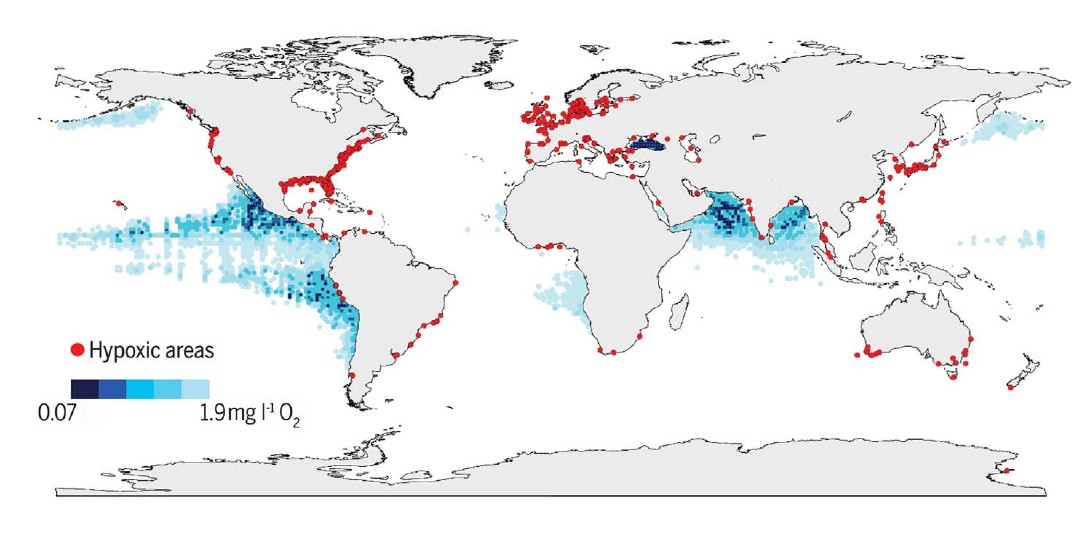Fisheries At Risk


Stony Brook University School of Marine and Atmospheric Sciences professor Dr. Christopher Gobler and Stephen Tomasetti detailed in an April 24-published study in the journal of the American Association for the Advancement of Science the harmful effects policy shortfalls on coastal hypoxia and acidification have on aquatic life, and ways to facilitate improved protection.
During the past two decades, scientists have learned how hypoxia, or low oxygen, and acidification, decreasing pH, can act and interact to harm marine organisms. Hundreds of low-oxygen or dead zones have been identified across the globe. Ocean acidification, a process resulting from the continued buildup of increasing atmospheric carbon dioxide in the oceans, has been discovered. And yet, regulation of dissolved oxygen and pH in coastal waters have remained unchanged.
Changes in human population centers and agricultural fertilizer use have accelerated delivery rates of nitrogen and phosphorus to coastal waters, often stimulating rapid accumulations of primary production. Resulting eutrophication processes, when a body of water becomes overly-enriched with minerals, are of less environmental relevance in well-mixed, ocean ecosystems. When they occur in warm, stratified, and/or poorly mixed waters, they can result in hypoxia and acidification. The Clean Water Act aims to restore and protect the waters of the United States from impairment; waters that do not meet state standards are listed as impaired, a designation that can initiate critical remediation actions. According to Dr. Gobler, the current saltwater dissolved oxygen and pH criteria of many states allow for harmful conditions to persist without amelioration. The pair of scientists are asking for more stringent numeric criteria.
“Our understanding of the dynamics of dissolved oxygen and pH and the effects on marine life have advanced dramatically this century to the point that it is now clear that criteria for pH and dissolved oxygen are likely to leave important marine species vulnerable to harm,” said the director of Stony Brook University’s Center for Clean Water Technology, and endowed chair of Coastal Ecology and Conservation.
Many ecologically and/or economically important shellfish and finfish that experience decreased survival and/or growth when exposed to hypoxia are further impaired by concurrent acidification. The reduction of both levels in coastal waters can individually adversely affect aquatic life, affecting a suite of physiological processes and increasing mortality rates, however, current regulations also do not consider their more severe combined effects. Not until the scientific field of ocean acidification had been established had their combined effects been broadly considered.
“Revising dissolved oxygen and pH criteria to reflect the latest science are important actions that will leverage the existing nationwide efforts to improve water quality and will help to produce and maintain the best possible outcomes,” said Tomasetti, a Science Teaching and Research to Inform Decisions fellow. “We believe that continued collaboration between scientists, community members, and all levels of government can revitalize our coastal waters.”
Environmental experts working to protect marine life see the need for better protection of coastal ecosystems.
“Together, ocean acidification and eutrophication are a double whammy, reinforcing each other — and increasingly harming marine and aquatic life,” said Dr. Lisa Suatoni, deputy director of the oceans division at the Natural Resources Defense Council. “Tomasetti and Gobler cogently present an emerging truth: to address this combined impact, we need to reexamine our current regulations and the criteria we use to assess water quality.”
The policy forum suggests that by incorporating recent acidification research into dissolved oxygen and pH policy, further improvements to coastal ecosystems are achievable. Many coastal states have established advisory groups consisting of researchers, stakeholders, and state officials to share information on the issue of coastal acidification.
This study concludes with recommendations to improve the protection of coastal animals, suggesting revisions of existing water quality criteria, further scientific experiments, and additional pH monitoring.
desiree@indyeastend.com



